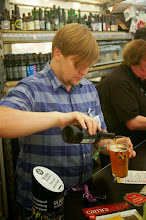Before I started writing about my all-grain
brews, I wanted to write a bit about how I started out. At the time it seemed
really easy to get started, but then none of the first few batches turned out
exactly as I wanted them to, which says something. I started brewing beer towards
the end of 2011 – it’s something I’d wanted to do for a long time but never had
the impetus to start. I was lucky enough to have parents that have made beer,
cider and wine intermittently throughout my childhood, so they had fermenters,
airlocks and hydrometers knocking around. As a hugely impatient novice, I had
the idea that I could flick through John Palmer’s How to Brew, buy some
ingredients, and suddenly be turning out decent brews. As I said – an
impatient, naïve novice. The hardest bit for me to get my head around was the
cleanliness. Everything needs sterilizing – fermenters, equipment, surfaces…
but not too much, as any trace of the chemicals you’ve used will do as much
damage to the brew as if you’d not bothered at all. A thin sodium hypochlorite
solution does not taste good – but more of that later.
The first brew was a beer kit called Citrus
Blast, put together by Pop’s Home Brew in Cheltenham. It seemed a bit too easy
– you got some dried yeast, two cans of Coopers LME and a couple of different
hop additions, each in their own bags. Boil them up with as much water as you
can fit in as big a pot as you can get your hands on, then after an hour tip it
into the fermenter, top up with cold water (which helps bring the temperature
down to 20C), then pitch some rehydrated Nottingham yeast. What we had after
fermentation was recognizably beer – deep brown, bit of malt, a bit of classic
English hops… it just wasn’t the sort of stuff I like to drink.
Brew Two was another kit, which should have
come out as a 5% stout, and consisted of a single hop bag and two cans of
Coopers Dark extract. I had the bright idea of cutting the overall volume to under
4 gallons instead of 5 in order to bump up the original gravity to 1.080 or
something silly and therefore, in theory, the eventual ABV. No taking into
account the yeast (it was the same dried Nottingham yeast) or the amount of
unfermentables in the Dark Malt Extract or anything – I told you I was naive.
It eventually bottomed out at something like 1.028, looked and smelled like
Marmite and tasted like, well, diluted Dark Malt Extract. Thinking it was a
write-off, we decided to play around with it a bit – splitting it into four
one-gallon demi-johns and putting some coffee beans into one, bourbon-soaked
oak chips into another, both oak and coffee into a third and leaving the fourth
gallon untouched. I’d read online about using coffee and oak to flavour stouts
in the secondary, and given that our extract beast seemed to be a bit of a
mess, I thought it would be an opportunity to try it out. We gave them all a
week, then bottled then. Incredibly, they turned out okay – they were clearly
not going to win any brewing awards, but the coffee and oak came through in the
various bottles to take the edge off the twang. I’m planning to leave a few
bottles for six months and see if they’ve improved.
At Christmas time I was given a 5-gallon
boiler, an immersion chiller and some other new equipment, and decided to make
Brew Three a recipe of my own. I adapted a recipe online for an Imperial IPA,
and,ordered three cans of light malt extract, some US hops (Apollo and Chinook)
and a vial of White Labs WLP001 California Yeast. The boil seemed to have gone
well, the OG was up at 1.070 where it should have been, and the hops smelled great.
Seven days later, it was down to 1.018 - despite me not making a starter, firstly because I didn't know exactly how and secondly because I hoped the yeast would pull through). We racked it to the secondary for
dry-hopping with more of the Chinook hops and left it to settle. However, when we came back to it in
the following days, there was an odd smell to it – instead of the crisp hop
aroma, there was a slight chlorine taint to it that got worse when I tasted a
sample. My theory is that there must have been some undissolved crystals of the
sodium hypochlorite in the bottom of the secondary that we hadn’t rinsed out
properly. The whole batch was ruined (although having said that, my brother
couldn’t really taste it, so drank every bottle over the course of a
fortnight…)
The lessons I learned from the first few
batches were:
- - Keep everything sanitised... but rinse everything before use to make sure there's no residue.
- - Don’t mess around too much unless you know what you’re doing. If you do have to start messing around, make copious notes.
- - Record everything… starting temps, OGs, FGs, everything.
- - Don’t be too ambitious to start with.
- - Read and learn as much as possible - the Palmer book is highly recommended.
- - Until you know what you’re doing, expect to make fairly mediocre beer at best
That's not to imply I'm any kind of expert now, but I'm definitely cringing a bit at remembering some of the stuff I've just written....



